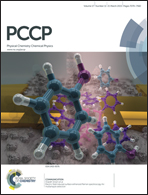N719- and D149-sensitized 3D hierarchical rutile TiO2 solar cells—a comparative study
Abstract
Poor dye loading on rutile TiO2 is one of the chief reasons for lower solar-to-electric conversion efficiency (η) in dye-sensitized solar cells (DSCs), compared to their anatase based counterparts. Previously, we showed that similar light harvesting for both rutile and anatase was realized by using a metal-free organic indoline dye, D149 [Sci. Rep., 2014, 4, 5769]. This was in contrast to the bulk of previous studies, which employed ruthenium based N719, leading to significant differences in light harvesting. To date, there has been no report directly comparing N719 and D149 for rutile based DSCs. In this work, three-dimensional hierarchical rutile TiO2 architecture (HRTA), consisting of one-dimensional nanorods, was successfully prepared via a facile hydrothermal method, and subsequently optimized as effective photoelectrodes for DSCs. Two dyes, N719 and D149, were used as sensitizers of the HRTA-based DSCs, with maximum η of 5.6% and 5.8% achieved, respectively. The higher η of the D149-sensitized DSC is ascribed to its higher extinction co-efficient, allowing a greater amount of light to be harvested with a thinner TiO2 layer. This study suggests that some of the limitations typically observed for rutile TiO2 based DSCs can be overcome through the use of strongly absorbing metal-free organic sensitizers. Furthermore, it reemphasises the importance of viewing DSCs as whole systems, rather than individual components.


 Please wait while we load your content...
Please wait while we load your content...